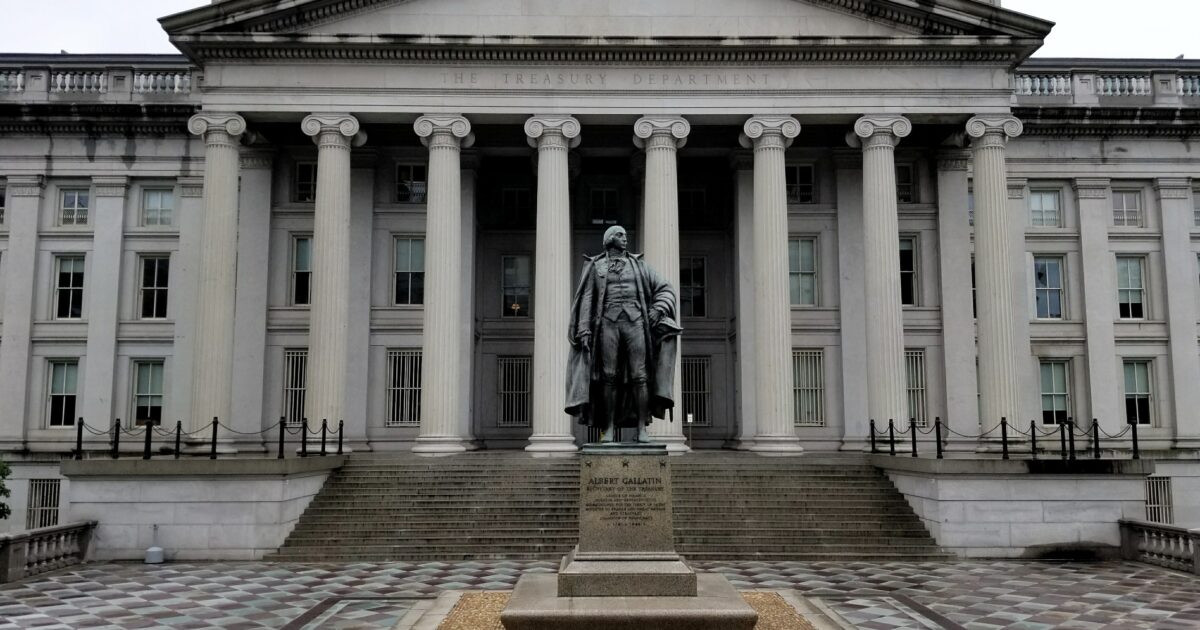Sealy J, U.S. Treasury Building, Washington, D.C., CC BY-SA 4.0, via Wikimedia Commons
Critics attack the president’s tariffs and economic policies, yet the world is investing in the U.S. at record levels. The very countries Trump has clashed with in trade disputes, and hit with massive tariffs, are buying up U.S. Treasury notes.
As of June 2025, foreign entities hold a record $9.13 trillion in U.S. Treasury notes, an $80.2 billion increase from May’s $9.05 trillion. This marks the fourth consecutive month above $9 trillion and represents nearly a $1 trillion (10%) increase compared to June 2024, when holdings stood at about $8.13 trillion.
Japan remains the largest foreign holder with $1.147 trillion in June 2025, up $12.6 billion from May. The United Kingdom holds the second position at $858.1 billion, up from $809.4 billion in May. China, the third-largest holder, maintained $756.4 billion, essentially flat from $756.3 billion in May.
China’s holdings remain well below their peak of over $1.3 trillion held between 2012 and 2016, as the country has been gradually reducing Treasuries to support the yuan amid slowing economic growth and trade barriers.
Part of China’s sales of Treasuries is due to the yuan losing value, forcing Beijing to prop up its currency. Another reason is that China has been buying U.S. agency bonds. China’s reserves have shifted from Treasuries to Agencies, with increased use of offshore custodians. The available evidence suggests that about 50 percent of its reserves are still held in dollar bonds.
Despite record-holding levels, tariff policies created significant volatility in transaction flows. There were substantial sales and liquidations earlier in the year, as countries and investors speculated on how long the tariffs would last and how they would impact the global economy. In the end, however, investors voted with their wallets, banking on the U.S. government.
Higher yields on U.S. Treasuries, fueled by inflation concerns and tariff impacts, have drawn more foreign investors seeking stronger returns. At the same time, global trade tensions and economic uncertainty have sustained demand for U.S. debt as a safe store of value.
This shows that, despite policy volatility and the dollar’s 11% drop in the first half of 2025, the steepest decline since 1973, Treasuries are still regarded as the world’s premier safe-haven asset.
Historically, U.S. bonds have been considered risk-free and are used as the global baseline for comparing investment options. A credit downgrade does not mean the U.S. is bankrupt; it simply reflects that mathematical models no longer assign a zero probability to default. In reality, the expectation remains that the U.S. will always repay its debts, since Congress has the power to tax across the world’s largest taxpayer base.
The most recent downgrade came in May 2025, when Moody’s lowered the U.S. credit rating from Aaa to Aa1. The agency cited growing debt from higher federal spending and reduced revenues due to tax cuts, estimating that extending the 2017 TCJA provisions would add $4 trillion to the debt over the next decade. Media critics portrayed this as evidence that President Trump had wrecked the economy.
In truth, however, downgrades have occurred under past administrations as well. Under President Biden, Fitch Ratings cut the U.S. rating from AAA to AA+ in August 2023, pointing to “fiscal deterioration,” a “high and growing government debt burden,” and an “erosion of governance” after a Republican debt ceiling standoff.
A decade earlier, under President Obama, Standard & Poor’s downgraded the U.S. from AAA to AA+ in August 2011, citing “political brinksmanship” and “less stable, less effective, and less predictable” governance during another debt ceiling showdown.
Despite these downgrades, U.S. Treasuries and the dollar remain the world’s premier reserve assets, and American government debt is still considered the safest and highest-paying sovereign investment available.
Global demand for U.S. Treasury bonds strengthens the dollar because foreign investors must first convert their local currencies (euros, yen, yuan, etc.) into U.S. dollars. This creates heavy demand in foreign exchange markets, pushing up the dollar’s value relative to other currencies. A stronger dollar, however, makes American exports more expensive abroad, hurting U.S. manufacturers and exporters.
The dollar’s decline in value this year is not necessarily a bad thing. The dollar had risen steadily since Trump’s first administration, and a correction was overdue. In fact, with reciprocal tariffs in place, an 11% weaker dollar helps offset some of the cost, giving U.S. exporters a built-in discount.
At the same time, the world is still investing in US treasuries showing that despite the rhetoric and criticism, the world has yet to find an alternative to the dollar.
The post Foreign Holdings of U.S. Treasuries at Record High, World Investing in US Economy appeared first on The Gateway Pundit.











